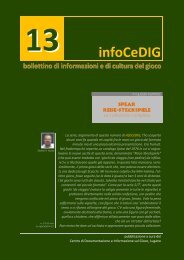Lugano - Centro di Documentazione e Informazione sul Gioco
Lugano - Centro di Documentazione e Informazione sul Gioco
Lugano - Centro di Documentazione e Informazione sul Gioco
Create successful ePaper yourself
Turn your PDF publications into a flip-book with our unique Google optimized e-Paper software.
<strong>Centro</strong> <strong>di</strong> <strong>Documentazione</strong> e <strong>Informazione</strong> <strong>sul</strong> <strong>Gioco</strong> [CeDIG] — Catalogo bibliografico<br />
Seconda <strong>di</strong>chiarazione dell'apertore | 5. Seconda<br />
<strong>di</strong>chiarazione del rispondente dopo la risposta <strong>di</strong> 1 s.a.<br />
| 6. Seconda <strong>di</strong>chiarazione del rispondente dopo la<br />
risposta <strong>di</strong> 1 a colore | 7. Seconda <strong>di</strong>chiarazione del<br />
rispondente dopo una risposta positiva senza salto | 8.<br />
Seconda <strong>di</strong>chiarazione del rispondente dopo una<br />
risposta positiva a salto | 9. Risposte all'apertura dopo<br />
interferenza avversaria | 10. Apertura <strong>di</strong> 1 s.a. | 11.<br />
Apertura <strong>di</strong> 2 s.a. | 12. Apertura <strong>di</strong> 2 quadri, 2 cuori, 2<br />
picche | 13. Apertura <strong>di</strong> 2 fiori | 14. Apertura <strong>di</strong><br />
barrage | 15. Interferenze su apertura avversaria | 16.<br />
Dichiarazioni <strong>di</strong> accostamento allo slam | II. Guida<br />
pratica allo standard | 1. Dichiarazioni <strong>di</strong> apertura | 2.<br />
Dichiarazione <strong>di</strong> 1° giro del rispondente | 3.<br />
Dichiarazioni <strong>di</strong> 2° giro dell'apertore | 4. Dichiarazioni<br />
<strong>di</strong> 2° giro del rispondente | 5. Risposte all'apertura <strong>di</strong> 1<br />
a colore interferita | 6. Risposte all'apertura <strong>di</strong> 1 senza<br />
atout interferita | 7. Dichiarazioni <strong>di</strong> 2° giro del‐<br />
l'apertore <strong>di</strong> 1 a colore su interferenza dell'avversario<br />
| 8. Dichiarazioni <strong>di</strong> 2° giro dcell'apertore <strong>di</strong> 1 senza<br />
atout su interferenza dell'avversario 4° <strong>di</strong> mano | 9.<br />
Interferenza del 2° <strong>di</strong> mano | 10. Risposte del 4° <strong>di</strong><br />
mano alle interferenze del 2° <strong>di</strong> mano | 11. Dichia‐<br />
razioni <strong>di</strong> 2° giro del <strong>di</strong>fensore che ha formulato in 1°<br />
giro un contro informativo | 12. Dichiarazioni <strong>di</strong> ri‐<br />
apertura del 4° <strong>di</strong> mano | 13. Dichiarazioni esplorative<br />
<strong>di</strong> slam<br />
Firpo L.<br />
INVITO AL BRIDGE. IL "FIORI TORINO"<br />
Mursia, Milano, 1987, 239p.<br />
Premessa | I. La storia | II. Le regole | III. La <strong>di</strong>chia‐<br />
razione. Il sistema "Torino" | IV. La giocata e il contro‐<br />
gioco | V. Percentuali e punteggi<br />
Gandolfi V.<br />
BRIDGE DEI PRINCIPIANTI, IL<br />
Mursia, Milano, 1968, 292p.<br />
Presentazione (G. Belladonna) | Prefazione | I. Le re‐<br />
gole fondamentali del gioco | II. Il gioco della carta |<br />
III. Il senza atout Stayman | IV. Apertura <strong>di</strong> due senza<br />
atout | V. L'apertura <strong>di</strong> due fiori Albarran‐Crodo<br />
Gloor S.J.<br />
BRIDGE PRATIQUE UNIVERSEL, LE<br />
É<strong>di</strong>tions Générales, Genève, 1952, 149p.<br />
Le Bridge pratique | Annonces | Les ouvertures |<br />
Aspect des donnes | Réponses aux ouvertures | Ré‐<br />
ponses aux ouvertures de couleurs | Réponses avec<br />
sauts sur ouvertire de 1 | Réponses sur ouvertures de<br />
2 à couleur | Enchères de chelems | Suite des<br />
annonces après interventions de l'adversaire | Les an‐<br />
nonces de la défense | Le contre et le surcontre | Le<br />
tableau résumé des annonces | Le jeu de la carte<br />
— 138 —<br />
Lebel M.<br />
BRIDGE IN UN'ORA [BRIDGEZ EN 1 HEURE]<br />
Mursia, Milano, 2000, 83p.<br />
Chi è l'autore | Prima della prima partita | Prima della<br />
prima lezione | Lezione n. 1 | Lezione n. 2 | Lezione n.<br />
3 | Lezione n. 4 | Lezione n. 5 | Lezione n. 6 | Lezione<br />
n. 7 | Lezione n. 8 | Lezione n. 9 | Lezione n. 10 | 10<br />
consigli per terminare<br />
Mollo V./Gardener N.<br />
BRIDGE FOR BEGINNERS<br />
Duckworth, London, 1964, 160p.<br />
Preface | Explanation of exercises | 1. Bridge explai‐<br />
ned: theory | 2. Bridge explained: practice | 3.‐7. Bid‐<br />
<strong>di</strong>ng | 8.‐12. Card play | Answers to exercises<br />
Pabis‐Ticci C.<br />
PRINCÌPI DEL BRIDGE, I<br />
Rizzoli, Milano, 1984, 204p.<br />
Nota introduttiva | I. La meccanica | II. Il gioco | III. La<br />
licitazione | 1. Le mani regolari | 2. Le mani irregolari |<br />
3. Le <strong>di</strong>chiarazioni dei <strong>di</strong>fensori | IV. La strategia | Con‐<br />
gedo<br />
Petroncini C.<br />
IMPARA IL BRIDGE DA SOLO<br />
Mursia, Milano, 1998, 397p.<br />
Presentazione (M. Di Egi<strong>di</strong>o) | Premessa | 1. Le regole<br />
del gioco | 2. Tecnica del gioco della carta | 3. Il gioco<br />
con il morto | 4. Il controgioco | 5. Il punteggio nel<br />
rubber e nei tornei | 6. La matematica della <strong>di</strong>chiara‐<br />
zione | 7. La logica delle <strong>di</strong>chiarazioni | 8. Fasi, criteri e<br />
tempi della <strong>di</strong>chiarazione | 9. L'impostazione del siste‐<br />
ma | 10. L'apertura bilanciata con 12‐15 punti: 1 fiori |<br />
11. Le aperture sbilanciate al livello <strong>di</strong> 1 con forza <strong>di</strong><br />
<strong>di</strong>ritto e <strong>di</strong> rovescio: 1 quadri, 1 cuori, 1 picche | 12.<br />
L'apertura bilanciata con 16‐19 punti: 1 senza atout |<br />
13. Le aperture tricolori: 2 fiori, 2 quadri | 14. Le <strong>di</strong>‐<br />
stribuzioni sbilanciate con 4 o più fiori ed un colore<br />
laterale almeno quinto | 15. Le aperture delle <strong>di</strong>stri‐<br />
buzioni sbilanciate <strong>di</strong> <strong>di</strong>ritto con 4/5 carte <strong>di</strong> fiori e 5/6<br />
carte <strong>di</strong> cuori o <strong>di</strong> picche: 2 cuori, 2 picche | 16. Le<br />
aperture delle <strong>di</strong>stribuzioni sbilanciate <strong>di</strong> rovescio con<br />
4/5 carte <strong>di</strong> fiori e 5/6 carte <strong>di</strong> cuori o <strong>di</strong> picche: 1<br />
cuori, 1 picche | 17. Le aperture delle <strong>di</strong>stribuzioni<br />
sbilanciate con 4/5 carte <strong>di</strong> fiori e 5 carte <strong>di</strong> quadri: 1<br />
quadri | 18. L'apertura bilanciata con 20‐22 punti: 2<br />
senza atout | 19. Le <strong>di</strong>stribuzioni monocolori con 6 o<br />
più carte <strong>di</strong> fiori | 20. L'apertura delle monocolori <strong>di</strong><br />
<strong>di</strong>ritto con 6 o più carte <strong>di</strong> fiori: 3 fiori | 21. L'apertura<br />
delle monocolori <strong>di</strong> rovescio con 6 o più carte <strong>di</strong> fiori: 2<br />
fiori | 22. Le <strong>di</strong>chiarazioni iniziali <strong>di</strong> sbarramento<br />
(barrage): 3 quadri, 3 cuori, 3 picche, 4 fiori, 4 quadri,<br />
4 cuori, 4 picche, 5 fiori, 5 quadri | 23. Le mani<br />
fortissime | 24. L'apertura bilanciata con 23 o più





![GIOCHI [in generale] - Centro di Documentazione e Informazione ...](https://img.yumpu.com/2673718/1/184x260/giochi-in-generale-centro-di-documentazione-e-informazione-.jpg?quality=85)